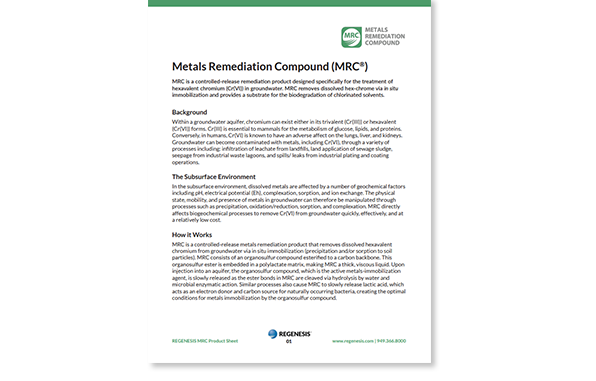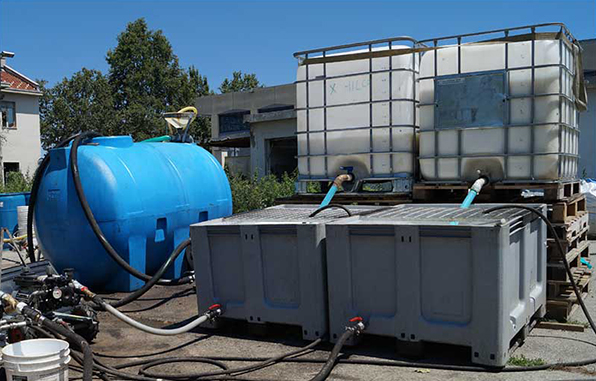


A REAGENT DESIGNED SPECIFICALLY FOR THE TREATMENT OF HEXAVALENT CHROMIUM CR(VI) IN GROUNDWATER
RESOURCES
How it Works
Metals Remediation Compound (MRC®) removes metals such as dissolved Cr(VI) from groundwater via in situ immobilization (precipitation and/or sorption to soil particles). MRC consists of an organosulfur compound esterified to a carbon backbone. This organosulfur ester is embedded in a polylactate matrix, making MRC a thick, viscous liquid. Upon injection into an aquifer, the organosulfur compound (the active metals immobilization agent) is released in a controlled manner when the ester bonds in MRC are cleaved via hydrolysis and microbial enzymatic action. Similar processes also cause MRC to release lactic acid which provides a carbon source for naturally-occurring bacteria and creates the optimal conditions for metals immobilization by the organosulfur compound.
MRC stimulates chromium immobilization using a two-part mechanism:
The organosulfur compound in MRC is a direct chemical reductant for soluble Cr(VI) and produces insoluble trivalent chromium (Cr(III)).
MRC can stimulate Cr(VI) reduction indirectly by providing lactic acid, which is rapidly metabolized by subsurface microbes and creates reduced species, like ferrous iron and sulfide which are known to chemically reduce Cr(VI) to the insoluble Cr(III) state.
MRC can also be used to treat sites with mixed hexavalent chromium and chlorinated hydrocarbon contamination because it provides the substrates needed to facilitate dissolved hexavalent chromium immobilization and reductive dechlorination. The dual-purpose feature allows MRC to effectively treat sites with co-mingled plumes because it eliminates the need for separate technologies to treat metals and chlorinated compounds. The organic substrate and lactate present in MRC accelerates the in situ biodegradation rates of chlorinated hydrocarbons (CHs) via anaerobic reductive dechlorination processes. Reductive dechlorination is one of the primary attenuation mechanisms by which chlorinated solvent groundwater plumes can be stabilized and/or remediated.
TARGET CONTAMINANTS:
– Chromium 6 (Cr(VI))
For a complete listing of treatable contaminants please visit our Range of Treatable Contaminants Page.
Typical Applications
APPLICATION/INJECTION:
– Permanent injection wells
– Direct-push injection points
– Soil mixing
NEXT STEPS:
If you currently have a project and need a remediation solution now, visit our Request a Design page. Have questions or want to explore some ideas? Contact Us to get in touch with a local representative.


 Americas
Americas Europe
Europe Français
Français Deutsch
Deutsch Italiano
Italiano Español
Español





